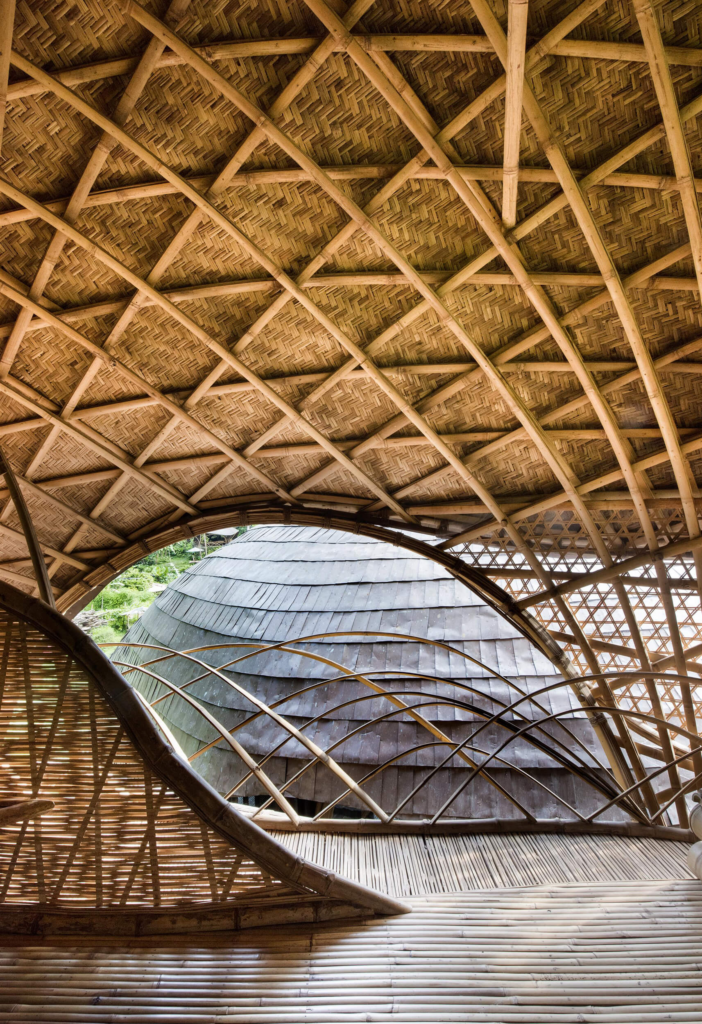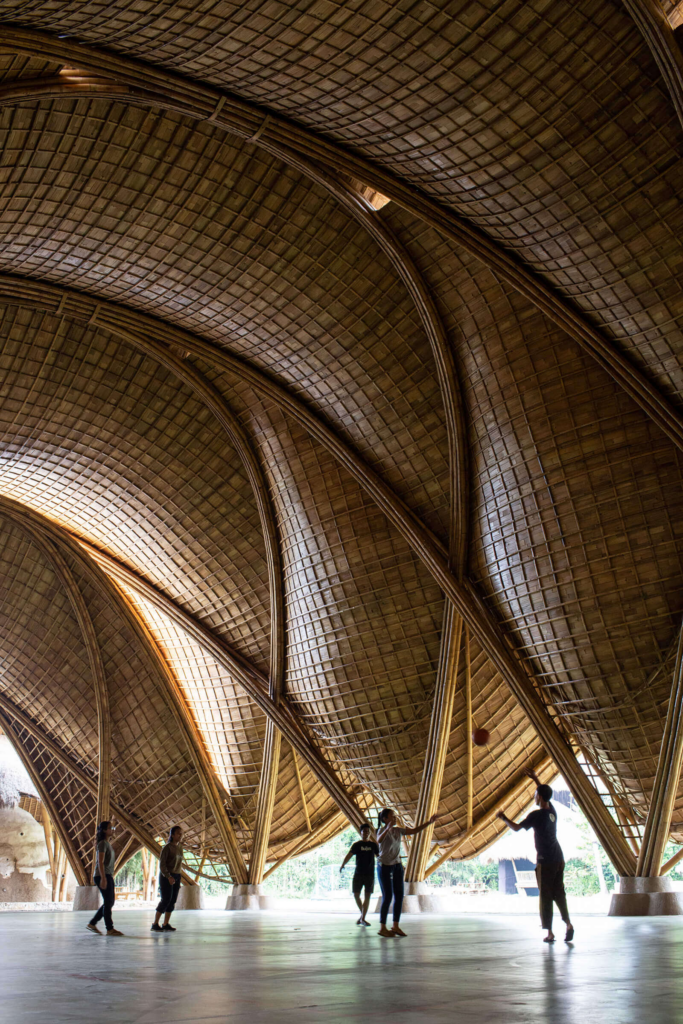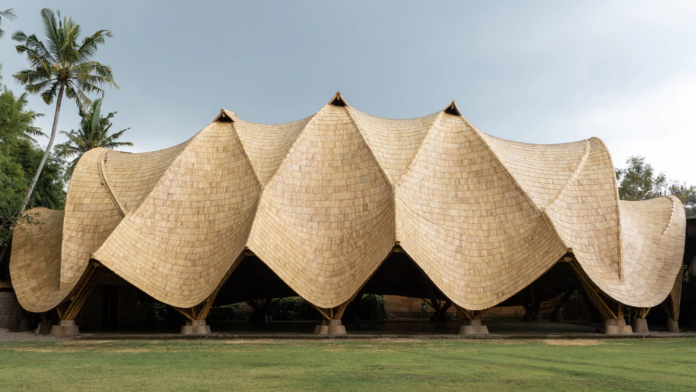[Video Transcript]
“There are lots of things that we’re still working on, but one thing I have learned is that bamboo will treat you well if you use it right.
It’s actually a wild grass. It grows on otherwise unproductive land — deep ravines, mountainsides…we watched it grow a meter in three days.
Now, we harvest from hundreds of family-owned clumps. Betung, as we call it, it’s really long, up to 18 meters of usable length. Try getting that truck down the mountain. And it’s strong: it has the tensile strength of steel, the compressive strength of concrete. Slam four tons straight down on a pole, and it can take it. Because it’s hollow, it’s lightweight, light enough to be lifted by just a few men, or, apparently, one woman.
And when my father built Green School in Bali, he chose bamboo for all of the buildings on campus, because he saw it as a promise. It’s a promise to the kids. It’s one sustainable material that they will not run out of. And when I first saw these structures under construction about six years ago, I just thought, this makes perfect sense. It is growing all around us. It’s strong. It’s elegant. It’s earthquake-resistant. Why hasn’t this happened sooner, and what can we do with it next?
So along with some of the original builders of Green School, I founded Ibuku. Ibu means “mother,” and ku means “mine,” so it represents my Mother Earth, and at Ibuku, we are a team of artisans, architects and designers, and what we’re doing together is creating a new way of building. Over the past five years together, we have built over 50 unique structures, most of them in Bali.
Until recently, it was almost impossible to reliably protect bamboo from insects, and so, just about everything that was ever built out of bamboo is gone. Unprotected bamboo weathers. Untreated bamboo gets eaten to dust…Borax is a natural salt. It turns bamboo into a viable building material. Treat it properly, design it carefully, and a bamboo structure can last a lifetime.
Build something extraordinary out of it. Inspire people. Fortunately, Balinese culture fosters craftsmanship. It values the artisan. So combine those with the adventurous outliers from new generations of locally trained architects and designers and engineers, and always remember that you are designing for curving, tapering, hollow poles. No two poles alike, no straight lines, no two-by-fours here. The tried-and-true, well-crafted formulas and vocabulary of architecture do not apply here. We have had to invent our own rules. We ask the bamboo what it’s good at, what it wants to become, and what it says is: respect it, design for its strengths, protect it from water, and to make the most of its curves.
So we design in real 3D, making scale structural models out of the same material that we’ll later use to build the house. And bamboo model-making, it’s an art, as well as some hardcore engineering.
And we bring it to site, and with tiny rulers, we measure each pole, and consider each curve, and we choose a piece of bamboo from the pile to replicate that house on site.
To reap the selective benefits and work within the constraints of this material, we have really had to push ourselves, and within that constraint, we have found space for something new. It’s a challenge: how do you make a ceiling if you don’t have any flat boards to work with? Let me tell you, sometimes I dream of sheet rock and plywood.
But if what you’ve got is skilled craftsmen and itsy bitsy little splits, weave that ceiling together, stretch a canvas over it, lacquer it. How do you design durable kitchen countertops that do justice to this curving structure you’ve just built? Slice up a boulder like a loaf of bread, hand-carve each to fit the other, leave the crusts on, and what we’re doing, it is almost entirely handmade. The structural connections of our buildings are reinforced by steel joints, but we use a lot of hand-whittled bamboo pins. There are thousands of pins in each floor. This floor is made of glossy and durable bamboo skin. You can feel the texture under bare feet.
And the floor that you walk on, can it affect the way that you walk? Can it change the footprint that you’ll ultimately leave on the world? I remember being nine years old and feeling wonder, and possibility, and a little bit of idealism. And we’ve got a really long way to go, there’s a lot left to learn, but one thing I know is that with creativity and commitment, you can create beauty and comfort and safety and even luxury out of a material that will grow back” (Hardy 2015).


Right: The Arc at the Green School by Ibuku
Ibuku’s bamboo structures are nothing short of impressive. The Green School gymnasium looks like concept art for some futuristic sci-fi novel. I feel like in a lot of western architecture, it’s considered above and beyond if curves are implemented into rather rectilinear forms. Ibuku’s architecture relies entirely on the curves and inconsistencies of bamboo.
Typically lumber has to go through several processes to become usable construction material. With bamboo, Ibuku has the ability to be unconcerned with uniformity. They are leaning into the functional properties of bamboo while also letting its materiality drive aesthetic choices.
To me, the most impressive part of Ibuku’s process is that they work directly with the material from start to finish. Their scale models are made of the same bamboo material they build with, and they are working with the inconsistencies of the material, it sounds like there isn’t any CAD involved. Ibuku is designing a future without the need for ‘modern’ or ‘conventional’ tools and techniques.
If I were to take inspiration from Ibuku’s design processes, what materials within state parks would I be able to work with directly? Are there local skills and craftsmanship that could inform the process? And what would it mean to interject uniformity within state parks?
Hardy, E. (2015). Magical houses, made of bamboo. Ted; TED Talks. https://www.ted.com/talks/elora_hardy_magical_houses_made_of_bamboo?utm_campaign=tedspread&utm_medium=referral&utm_source=tedcomshare




